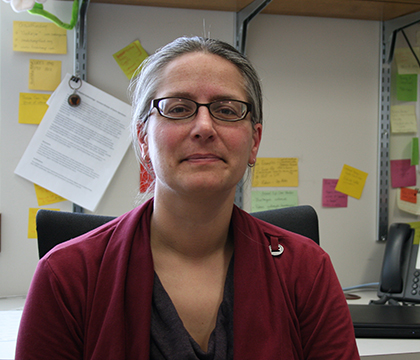
Bringing the U of S together with One Health
When you spend a lifetime studying a single discipline, it can become a challenge to effectively communicate with those from other fields.
By U of S CommunicationsAs an associate professor at the University of Saskatchewan's Western College of Veterinary Medicine, Tasha Epp is quite familiar with this problem. Her work could have her interacting with experts in human health, agriculture and beyond, and she wants to make the collaborative process as simple as possible.
"When we're talking with people from other disciplines, sometimes you're not always speaking the same language even when you're speaking the same words," she said, explaining how technical definitions can be very different even when terminology is quite similar.
To make that goal a reality, Epp is helping to guide the creation of the university's One Health certificate, a new program that merges disciplines to the benefit of students and researchers alike.
One Health is an undergraduate program built around blending the disciplines available on campus, bringing together researchers to work collaboratively and training students in areas they might otherwise have no interaction with. Implementation is currently aimed at an official launch in fall 2016.
The certificate is adapted from what is known as One Medicine, a popular program in American schools that combines human and veterinary medicine. The result is an initiative that looks at broader issues than either can fully tackle separately, such as cross-species diseases and the effects not just on living beings but also on the environment they live in and the food they rely on.
But once food, water and environment came into play, Epp said, it was only natural to bring other U of S disciplines into the fold as they planned One Health's implementation.
"How can you look at water or agriculture without bringing in the environmental sciences? For us here it really became much broader than just looking at human and veterinary medicine. We've really taken it quite a bit further than other proponents for one health have," she said.
In fact, even though similar programs exist elsewhere in the country, the resources available at the U of S will make its One Health certificate the first of its kind in Canada.
"We are the only campus in Canada that has all the health sciences plus veterinary medicine on the same campus, as well as agriculture, schools of environment and of public health," Epp said.
"We're quite unique in that way, and it allows us to bring together a number of disciplines that many other universities would not be able to inside themselves."
Patricia Farnese is a perfect example of One Health—for which she is also on the organizational committee—in motion.
As an associate professor of law, Farnese does not jump to mind when discussing health sciences.
However, since her work involves the regulation of infectious diseases and its connection to wildlife and environmental land use, she fits quite well under One Health's umbrella structure. Farnese emphasized the strengths that One Health could provide to students just entering the academic world, providing them with a broader spectrum of knowledge to pull from as they go into their careers increasing their ability to collaborate with peers from other areas of research.
"It will give students the opportunity to see things that are outside of their disciplinary experience. Particularly for students who are in the health professions and law, it's an opportunity to develop some skills interprofessionally," Farnese said.
"It's a chance to think about your frames and understandings, and how those might be different than somebody else's and, as you go to work with them in the future, to think about ways that you can overcome those boundaries more effectively."
Written by Henrytye Glazebrook.
